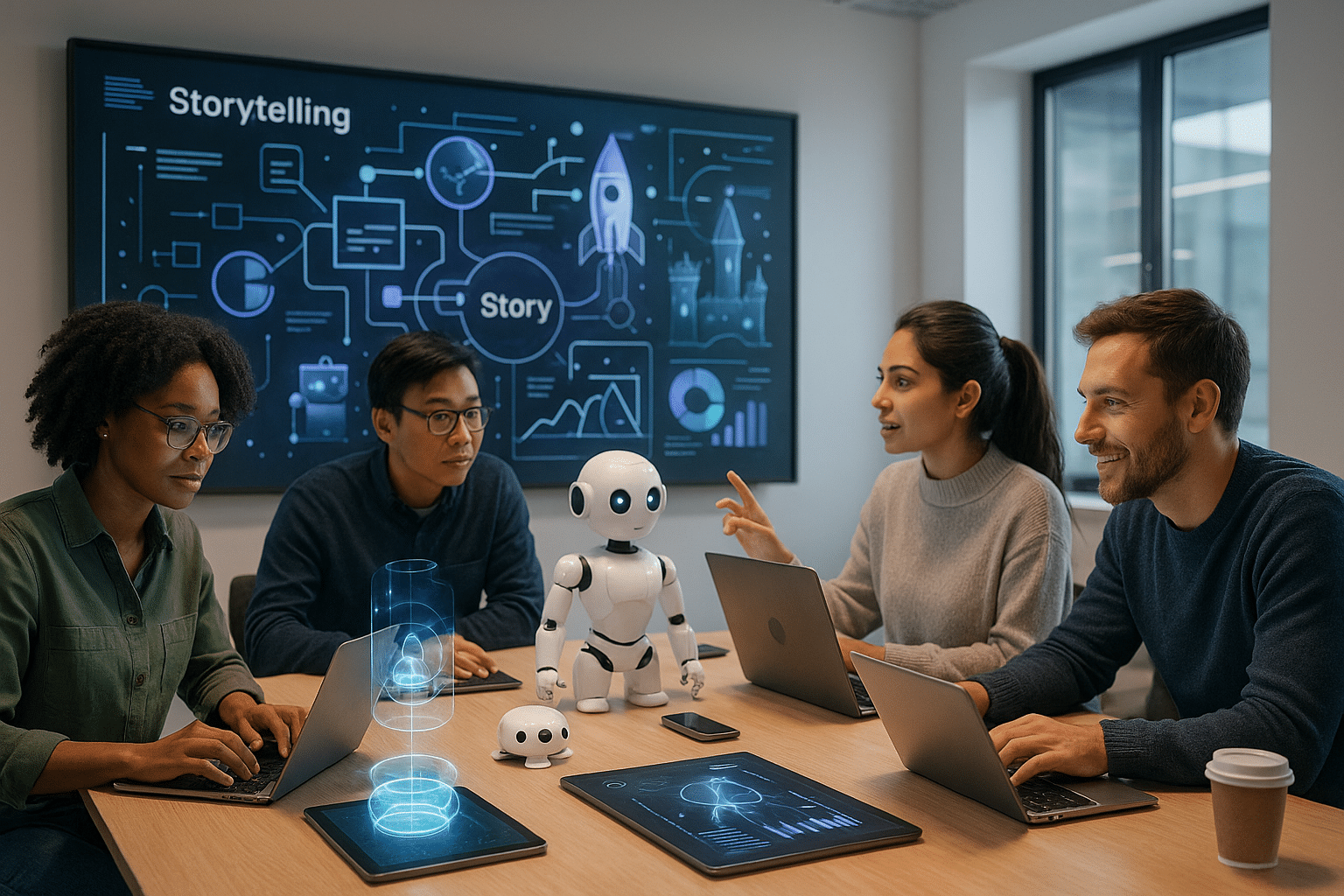Perhaps, you are thinking of HAL 9000 from 2001: A Space Odyssey or Samantha from the movie Her. 🎥 However, we are not just talking about AI characters in stories but AI as the storyteller itself. This is not a mere imagination of Hollywood, but a reality that’s unfolding in the digital realm, pushing the boundaries of what we thought machines were capable of.
In this article, we delve into the fascinating intersection of artificial intelligence and storytelling, charting the course from the initial hesitant steps to the groundbreaking developments that are shaking up the narrative landscape. 📚
The Advent of AI in Storytelling
The entrance of AI into the creative sphere was met with a mix of curiosity, apprehension, and a healthy dose of skepticism. After all, storytelling is an inherently human trait, a complex concoction of experiences, emotions, and nuances. Can machines really replicate that? The short answer is – not yet. But they’re getting remarkably close. 🤖
Today’s AI algorithms can already churn out coherent and engaging narratives, putting together elements of a story in ways that can seem strikingly human. The frontier of AI creativity is constantly expanding, as the machines learn to master not just the structure but also the subtleties of storytelling.
Exploring the Potential of AI Storytelling
The journey of AI storytelling is as intriguing as it is innovative. In the beginning, the narratives were simplistic, the language stilted. But as the technology evolved, so did the stories. They became more complex, more nuanced, more human. 📈
Now, AI-powered platforms are creating original content, from screenplays to news articles, and even poetry. They’re helping scriptwriters break story arcs, authors fine-tune their prose, and marketers craft compelling brand narratives. It’s a brave new world out there, and AI is carving its place in it, one story at a time.
Understanding the Mechanics
How does AI manage to weave narratives that captivate the reader? The answer lies in the intricate algorithms and powerful machine learning models. AI uses data, lots and lots of it, to learn the art of storytelling. 🧠
It starts with training the AI on vast text corpora, teaching it the rules of grammar, syntax, and storytelling. Then comes the more complex part – understanding the nuances, the emotions, the subtexts. This is where advanced machine learning techniques, like Natural Language Processing and Deep Learning, come into play.
Looking Ahead: The Future of AI Storytelling
So, what’s next for AI in storytelling? We’re just at the dawn of this exciting era. While the possibilities are vast and varied, there are also challenges, questions that need answering, and ethical considerations to grapple with. 😇
In the forthcoming sections, we will dissect these aspects, taking you on a journey through the intricacies of AI-driven narratives, the potential benefits and risks, and how this technological marvel is reshaping the narrative landscape, forever.
Whether you are a seasoned tech enthusiast, a storytelling aficionado, or simply someone intrigued by the limitless potential of AI, this deep-dive will offer you a glimpse into the future of storytelling. So, buckle up and join us on this thrilling exploration into the world of AI and its increasing influence on the art of storytelling. 🚀
Unlocking the Potential of AI in Storytelling: An In-Depth Exploration
Artificial Intelligence (AI) is no longer a concept confined to the realms of science fiction. It has permeated every industry, from healthcare and finance to transportation and entertainment. But perhaps one of the most intriguing applications of AI is in the world of storytelling. Imagine a machine that can generate compelling narratives, engage with audiences in meaningful ways, and even make us question the very nature of creativity. This might sound like a distant future, but it is closer than you might think.
In this article, we will delve into the fascinating world of AI storytelling, exploring how machines are learning to create, the potential they hold, and the challenges they face. By the end of this exploration, you’ll have a deeper understanding of this revolutionary technology and its implications for the future of storytelling and creativity.
Understanding How Machines Learn to Create
The cornerstone of AI storytelling is machine learning, a subset of AI that provides systems the ability to automatically learn and improve from experience without being explicitly programmed. This happens through the process of data analysis and pattern recognition. But how does this translate to creativity and, specifically, storytelling?
The first step involves teaching the machine to understand language. This is achieved through Natural Language Processing (NLP), a branch of AI that helps machines understand, interpret, and generate human language. NLP is what allows AI to read a book, understand a movie script, or write a news article.
Once the machine has a grasp of language, it can start learning to create. This is where machine learning comes into play. The AI is fed a large amount of data – in this case, stories – and it learns to recognize patterns within this data. It learns the structure of a story, the development of characters, the progression of a plot, and so on. Eventually, it can use this knowledge to generate new stories.
Tools and Techniques for Teaching Machines to Create
One of the most popular tools for teaching machines to create is Google’s TensorFlow, an open-source machine learning framework. TensorFlow is particularly suited for NLP tasks, making it a perfect tool for AI storytelling. It allows developers to build and train neural networks, which are designed to mimic the human brain’s ability to recognize patterns and make decisions based on them.
Another technique is the use of Generative Adversarial Networks (GANs). GANs consist of two neural networks – a generator and a discriminator – that work together to produce new, original content. The generator creates a piece of content, and the discriminator evaluates it. If the content is not good enough, it sends feedback to the generator, which then improves its creation. This process continues until the content reaches a satisfactory level of quality.
Finally, there’s the use of reinforcement learning. This is a type of machine learning where an agent learns to make decisions by taking actions in an environment to maximize a reward. In the case of AI storytelling, the ‘reward’ could be reader engagement, emotional impact, or any other metric that indicates a successful story.
Exploring the Power and Potential of AI Storytelling
The power of AI storytelling lies in its ability to generate infinite amounts of content, tailored to the individual preferences of each reader. This could revolutionize industries like publishing, advertising, and entertainment, providing personalized content on a scale previously unimaginable.
AI can also assist human authors by providing suggestions, generating ideas, and even writing portions of text. This could free up authors to focus on the more creative aspects of writing, improving the overall quality of their work.
Furthermore, AI storytelling can create interactive narratives, where the story changes based on the reader’s choices. This has exciting implications for the world of video games, virtual reality, and interactive movies. Imagine a game where the storyline adapts to your decisions in real-time, creating a truly immersive and personalized gaming experience.
The Impact of AI Storytelling on Society and Culture
AI storytelling has the potential to impact society and culture in profound ways. It could democratize storytelling, allowing anyone to create and share their stories with the world. It could also change the way we consume media, as AI-generated content becomes more commonplace and accepted.
However, there are also challenges and ethical considerations. What happens when machines start creating content that is indistinguishable from human-created content? What are the implications for copyright and intellectual property? And what about the potential for AI to create misleading or harmful content? These are questions that society will need to grapple with as AI storytelling continues to evolve.
Case Studies of AI Storytelling in Action
AI storytelling is already being put to use in various ways. Here are a few examples:
- OpenAI’s GPT-3: This AI model is capable of writing incredibly human-like text, from news articles to poetry. It can even generate creative stories based on prompts given by users. Check out this video by OpenAI on YouTube to see GPT-3 in action: “Playing with GPT-3 – OpenAI’s Language Prediction Model”.
- Quill: This AI writing assistant by Narrative Science can generate narratives from data, making it useful for journalism and business intelligence. It can create news articles, financial reports, and more, all in a matter of seconds.
- AI Dungeon: This is an interactive text adventure game where the story is generated in real-time by an AI, based on the player’s choices. It’s a fantastic example of how AI can create immersive, interactive narratives.
These examples demonstrate the potential of AI storytelling, but they also highlight the challenges. The text generated by these AI models can sometimes be nonsensical or off-topic, indicating that there’s still room for improvement.
The Future of AI Storytelling: Opportunities and Challenges
The future of AI storytelling is full of opportunities and challenges. On one hand, there’s the potential for personalized, interactive content on a scale never seen before. On the other hand, there are significant ethical and societal concerns that need to be addressed.
The key to navigating this future will be collaboration between humans and machines. AI can assist human authors, but it can’t replace them. At least not yet. Human creativity, with its ability to think outside the box and understand complex emotions, is something that AI has yet to replicate.
As we continue to explore the power of AI storytelling, let’s strive to use it as a tool for enhancing human creativity, rather than replacing it. Let’s use it to tell stories that educate, entertain, and inspire, pushing the boundaries of what’s possible in the world of storytelling.
Discover More About AI Storytelling
If you’re intrigued by the potential of AI storytelling, I encourage you to delve deeper into the subject. Watch the video “Artificial Intelligence and Storytelling” by TEDx Talks on YouTube. It provides a comprehensive overview of how AI is transforming the art of storytelling. Also, take a look at this comparative table that illustrates the key differences and similarities between human and AI storytelling:
| Human Storytelling | AI Storytelling |
|---|---|
| Creative and emotional depth | High volume and speed |
| Subjective and personal | Objective and data-driven |
| Limited by human capacity | Scalable and customizable |
The journey of AI in storytelling is only just beginning. It’s an exciting time to be a part of this revolution, and I can’t wait to see where it takes us next. Stay tuned for more in-depth explorations of AI and creativity. Until then, happy reading and happy storytelling! 🚀📚🌟

Conclusion
In the vast and intricate realm of technology and engineering, we have embarked on a profound journey of exploration and understanding, with each paragraph acting as a stepping stone to a higher level of enlightenment. Recapping the insights we’ve shared, it becomes evident that the true power of this knowledge lies in its ability to unravel the intricacies of complex technical concepts, shedding light on their applicability and significance in the real world.
We have navigated through the winding paths of software engineering, taking a deep dive into its essential components and their roles in shaping the future of technology. From the basic principles of coding and programming to the advanced realms of machine learning and artificial intelligence, our discourse has been an attempt to demystify the complex web of digital technology and bring its wonders within the grasp of understanding.
The importance of this knowledge cannot be overstated. It is the foundation upon which we build the future, and a key instrument in driving innovation and change. We have established how crucial it is to understand the inner workings of technology, not only for those involved in the field of IT and engineering, but also for those who wish to stay informed and ahead of the curve in this rapidly evolving world.
Your engagement and participation in this journey of learning has been invaluable. Your comments, shares, and applications of the knowledge we’ve shared are a testament to the impact that this information can have. The power to transform the world lies in your hands, and with each new concept learned, you take one step closer to becoming a catalyst for change.
We encourage you to continue this journey of learning, to delve deeper into the complex universe of technology and engineering. Take the knowledge you’ve gained, share it, apply it, and watch as the ripples of your actions make waves in the world.
😊👍
If you enjoyed this article, please feel free to comment and share your thoughts below.
Explore more in-depth articles and research papers on ResearchGate🔍📚
Follow Rodrigo Almeida on Medium for more insightful tech articles👥🚀
Your journey of discovery doesn’t have to end here. Khan Academy offers a wealth of resources to expand your knowledge in software engineering and IT. 🖥️📖
Keep learning, keep sharing, and most importantly, keep pushing the boundaries of what you know. For it is in the pursuit of knowledge that we truly grow and thrive.
And remember, your voice matters. Your thoughts, ideas, and insights have the potential to drive meaningful discussions and catalyze change. So, don’t hesitate to engage in the conversation and share your perspectives with the world.
Back to top
Onwards and upwards, to the future we go. 🚀🌟
Sources:
[1] MIT Technology Review
[2] Wired
[3] Scientific American
#technology #engineering #software #learning



